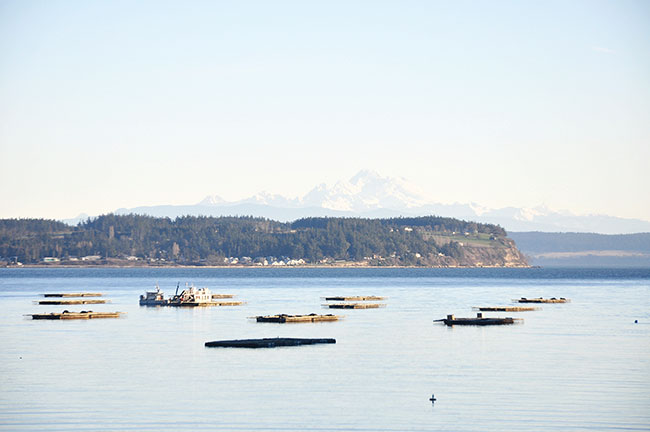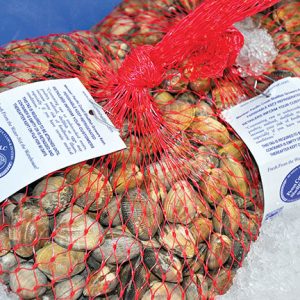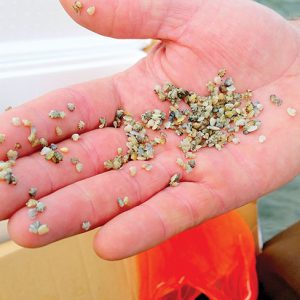
Washington State clam farmer opens up
June 4, 2021
By JULIA HOLLISTE
Shellfish farmer discusses clam aquaculture, industry challenges
 Penn Cove Shellfish farm in Samish Bay in Puget Sound
Penn Cove Shellfish farm in Samish Bay in Puget Sound Beginning with the first daylight of Spring’s low tides, Manila clams (Venerupis philippinarum) begin a two-year growing process to maturity at Penn Cove Shellfish in Washington State.
“We lay our predator nets, 4 ft x 100 ft, on the sand and bury the edges and install rebar staples every 20 feet for the length of the net,” said Ian Jefferds, owner and general manager of Penn Cove Shellfish. “Then, on a small incoming tide we sprinkle pre-measured volumes of 2380-micron clam seed, for a density of about 80 clams per square foot. We farm our Manila clams in Samish Bay, located in the northern Puget Sound, just east of the San Juan Islands.”
The clams fall into the water and through the 3/8-inch mesh and quickly burrow into the sand. Technicians have to sweep the macro algae off of the nets monthly until the clams are ready to harvest. Two sizes of the Manila clams are “on the menu” – Mediums (1.5 inches –1.75 inches) and Hilton Petite Manila (1.25 inches).
Penn Cove Shellfish has been fortunate not to experience disease issues, however it had a 100-year winter storm in 2018 that lasted about two weeks during a low tide run. It killed about 50 percent of the crop planted above the 1-foot tide level. The storm brought wind and snow and ice covered much of the bay, which is highly unusual for the area.
For over 30 years, the company sold clams grown by allied growers. It started to farm its own clams in 2016, adding to its product range that includes mussels and oysters.
Jefferds said deciding to farm clams over oysters was an easy decision. “Supplies of farmed clams gets tight periodically and our customers expect a consistent supply, so we began farming them to add to our supply base.” Farming clams also take less work than oysters, he said.
The company is vertically integrated – it harvests, packs and distributes the clams locally and to national restaurants and wholesalers.
Penn Clove clams have been on the menu at many full-service restaurants, including the nearby Front Street Grill, in Couperville, WA for almost 11 years.
“Our customers love their clams,” said restaurant manager Laura Price. “We get our fresh clams delivery twice a week. They are served with white wine, garlic, thyme, lemon and butter sauce or sautéed with a side of garlic toast or linguini.”
There are a few usual snags that occur in day-to-day operations and Jefferds offers a few remedies.
“We have not overcome all pitfalls but have learned to work around some,” he said. “Keeping a good crew on board year-round has been tough, even though we start at a high pay rate with benefits, many people choose not to work with the low-tide schedule, which changes daily and seasonally.”
Permitting has been the other big issue in Washington State, the state and federal government’s changing permitting requirements has hindered growth and many opportunities.
Starting a shellfish operation could be a great idea, if someone already has private tidelands or a tidelands lease. Jefferds says it depends on location; clams do well in some places and not in others, and some areas are more affected by weather or predators, so it is very site specific as to whether it makes good sense.
Predators in Samish Bay include several species of diving ducks, which come by as they migrate along the Pacific Flyway, north and south. They love the tender juvenile shellfish and will eat everything in sight if the clam flats are not protected. Crabs are also a problem.
Aside from predators and a fickle climate, Jefferds says there are other troublesome challenges facing the shellfish industry in the New Year.
“Labor shortages and unaccountable government bureaucracy have been the two largest factors affecting our shellfish farm over the last 10 years and we do not see those improving,” he said. “We continue to work on mechanizing all processes possible to offset the labor issues, but we don’t know what to do about the bureaucrats in the permitting agencies which appear to not mind hindering commerce, employment and opportunity.”







